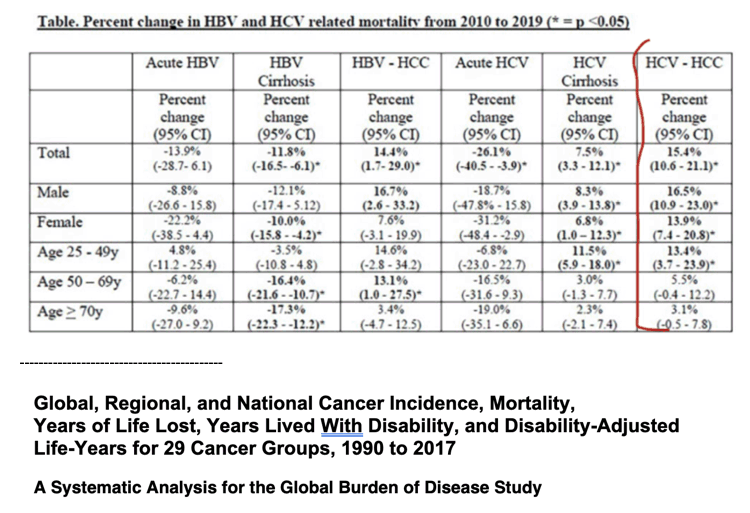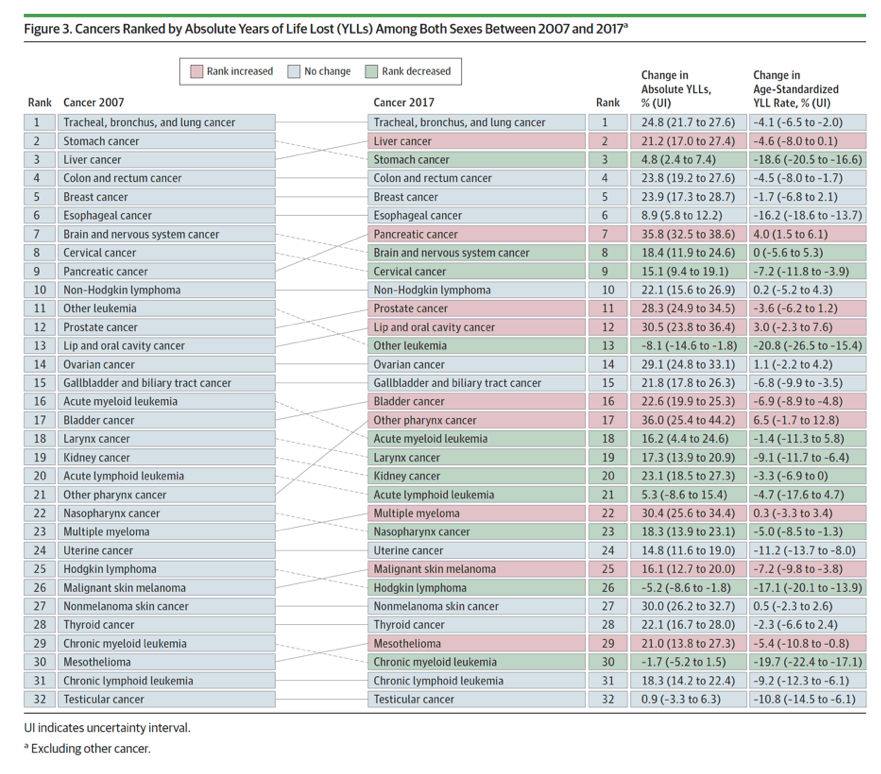| |
Liver Cancer Deaths, HCV & HBV HCC Increasing
|
| |
| |
Download the PDF here
AASLD: GLOBAL TRENDS IN CAUSE-SPECIFIC MORTALITY AND DISABILITY ADJUSTED LIFE YEARS RELATED TO HEPATITIS B VIRUS AND HEPATITIS C VIRUS FROM 2010 TO 2019 (11/22/21)
From 2010 to 2019, significant declines in mortality were observed for patients with HBV cirrhosis (-11.8%, 95% CI -16.5 to -6.1, p<0.05) and acute HCV (-26.1%, 95% CI -40.5 to -3.9, p<0.05). However, significant increases in mortality were observed for patients with HBV-HCC (14.4%, 95% CI 1.7-29.0, p<0.05), HCV cirrhosis (7.5%, 95% CI 3.3-12.1, p<0.05), and HCV-HCC (15.3%, 95% CI 10.6-21.1, p<0.05).

-------------------------------------------
JAMA Oncology 2019
The most common causes of cancer deaths and DALYs for men were TBL cancer (1.3 million deaths and
28.4 million DALYs), liver cancer (572 000 deaths and 15.2 million DALYs), and stomach
cancer (542 000 deaths and 12.2 million DALYs). For women in 2017, the most common
incident cancers were NMSC (3.3 million incident cases), breast cancer (1.9 million incident
cases), and colorectal cancer (819 000 incident cases). The leading causes of cancer deaths
and DALYs for women were breast cancer (601 000 deaths and 17.4 million DALYs), TBL
cancer (596 000 deaths and 12.6 million DALYs), and colorectal cancer (414 000 deaths
and 8.3 million DALYs).
7. Liver Cancer - "35% increase in cases between 2007 and 2017" -
In 2017, there were 953 000 (95% UI, 917 000-997 000) incident cases of liver cancer globally and 819 000 (95% UI, 790 000-856 000) deaths.
Liver cancer caused 20.8 million (95% UI, 19.9-21.8 million) DALYs in 2017, with 99% coming from YLLs and 1% coming from YLDs (eTable 15 and eFigure 4 in the Supplement). Globally, liver cancer was more common in men, with 1 in 42 men developing liver cancer compared with 1 in 118 women.
The highest odds of developing liver cancer were in high-middle SDI countries for men (1 in 31) and in middle SDI countries for women (1 in 94), whereas the lowest were seen in low SDI countries (1 in 98 men and 1 in 177 women) (eTable 16 in the Supplement). Population aging and population growth were the drivers of the increase from 705 000 (95% UI, 690 000-734 000) cases in 2007 to 953 000 (95% UI, 917 000-997 000) cases in 2017 (eTable 14 and eFigure 11 in the Supplement). Of the 35% increase in cases between 2007 and 2017, 17% was due to population aging, 13% due to population growth, and 6% due to an increase in age-specific incidence rates.

| |
| |
| |
|
|
|